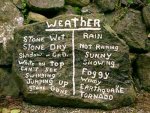Hi Paul,
Oh dear, 20 posts in the last day - where to start?
Including all the logging, analysis and presentation, your #25 specification is a BIG project and can't be particularly cheap with a RPi, URF and ERF (just one?), plus all the sensors. Personally, I'd omit the "UV" (Index) as being irrelevant and unmeasurable for a "hobby" project (however
IR is definitely worthy of consideration). But the whole topic of (useful) solar/illumination measurement is an absloute
can of worms that could easily fill numerous threads in itself.
A reasonable, complete weather station to that specification can be bought off-the-shelf for less than £100, often £50. Chinese-made of course and with many limitations, but time might be better spent improving some of the known "features". For example, the vane can be considerably improved with a couple of "button" magnets and a spot of glue.

Incidentally, I was amused by the specification sheet linked via #28 quoting the "calibration data" to
4 significant figures. The manufacturer only
claims +/-10% accuracy (and that I suspect is more in hope than reality).
But back to the original topic header. Nearly ALL the wind speed sensors mentioned here need to be
calibrated against a known reference. Not easy, particularly when most don't even have a linear scale (measured value/windspeed). The (Ultrasonic) "time of flight" method is about the only directly-calibrated method and certainly worthy of consideration. Perhaps it's not even necessary to use an ultrasonic frequency as the sensor presumably will be stuffed up at the top of an outdoor mast.
The basic maths is easy: speed of sound =~ 1,000 feet/second so time of flight is 1ms for 1 foot. To measure windspeed to better than 1mph needs a resolution of ~ 0.1%, or 1us for a 1 foot spacing. That's probably pushing a standard PICaxe/rangefinder - equivalent to your robot ranging to much better than 1mm accuracy.
However, IMHO the solution is simply to compare the
phase of the transmitted and received signals. That can be done with a flip-flop, a low-pass filter (one R+C) and the A/D input of a PICaxe. It certainly can be made to work (I did so 20+ years ago using the cheapest available micro) but it might be an interesting challenge to try to do it all using the PWM driver, internal comparator and SR flip-flop of a (M2) PICaxe.
Cheers, Alan.


